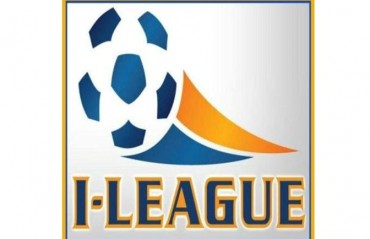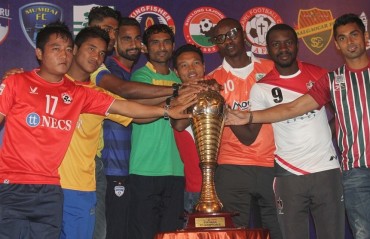SUNBURNT TERRACE: The Parachute Paradox- ISL & I-League merger, pro-rel conundrums
- By Chiranjit Ojha

- November 28, 2016

THE EVER-CHANGING SHAPE of the Indian football landscape makes it hard to assess, in one word, whether everything is rapidly falling apart or falling into place. The recent departure of Goan clubs from the I-League -- mere additions to a long list of fallen institutions at a time when India has the highest top division club mortality rate in the world -- has given rise to a situation where the powers that be have been forced to put all their cards on the table.
In the last few weeks, as it became apparent to the top brass that the Goan clubs were indeed about to pull out, the same old patronising pretensions, the feigning of an open-ended discourse, seemed to disappear. First, it was AIFF President Praful Patel's "cat among pigeons" comment that made the death of clubs look like a natural -- and perhaps preferred -- outcome for the Federation. Then a few days back, AIFF General Secretary Kushal Das openly lashed out at the departing clubs, saying FC Goa had way more supporters than Salgaocar and SCG; perhaps implying that it was okay for a Federation to brush off less popular clubs.
This kind of open denigration of departee clubs seems unusual even for AIFF, who have remained nonchalant but respectful as clubs like JCT, Mahindra United, Pune FC, Rangdajied United, and Royal Wahingdoh stepped off the wagon one by one. So what's different this time? What's forcing the Federation to exhibit this unsavoury honesty?
A big part of the reason is that the Goan rebellion is the first time the death of I-League clubs has got under the AIFF's skin. In the previous instances of clubs folding from the I-League, AIFF still had enough number of clubs to go ahead and hold an I-League that passed the minimum required benchmarks set by the AFC. Couple that limited impact on the league itself with the general apathy of the media towards Indian football and it wasn't much of a problem for AIFF to keep the show running without a hitch.
But this time, all those departures that slowly piled on have finally reached a critical level and come back to haunt AIFF. Because for the first time they are genuinely having to scramble to get enough teams for the I-League. The minimum a Federation has to do in a season is to run a full-sized league and at a critical time when both AFC and FIFA are watching India closely, this reflects badly on AIFF.
AFC requires a top division club to play at least 18 domestic matches, including league and cup to be eligible for a place in the Champions League (recently the number has been hiked to 27, but that doesn't apply until next season and India can probably get an exemption citing the league merger that they need to work out). Last season AIFF managed to do it by holding a 9-club league and a Federation Cup. This time, left with 6 clubs in the league thanks to the Goan exodus, AIFF for the first time faced the genuine possibility of a failed league season. And to avoid that, AIFF had to go down a rabbit hole of bending and breaking their own rules.
Red cards
Going against rules isn't really a new thing for AIFF, though. They flouted a hundred international footballing rules and norms when they let IMG-Reliance start a private tournament that encroached on the national league. The very reason for this urgency in merging (or "re-structuring") the domestic leagues is an effort to return to a coherent structure that follows all the rules. But the path towards it has pushed them further and further to bend more rules.
First, they had to bring back Aizawl FC from the second division; a retrospective strike-off of last season's relegation rules. In doing that, they broke yet another norm by giving Aizawl FC a second year of exemption from fulfilling the required licensing criteria. This allowed Churchill Brothers to file a petition in the court seeking a return to I-League with a similar exemption (the official reason they got kicked off the league was that they failed to fulfill licensing criteria) and thanks to AIFF's desperation to have enough clubs or newfound political goodwill or whatever reason, there's a good chance that they will make a dramatic return to the top division.
Now, there's nothing wrong with Aizawl FC and Churchill Brothers returning to the I-League. Both have a lot to offer the top division. But that doesn't mean their return isn't bending the existing rules to a breaking point.
Self goal
Then there's the issue of the corporate entrants. AIFF called for tenders a long time ago, and after an extension or two, finally when the bids came in, it turned out that all three applicants -- Chennai City, FC Bardez and Minerva AFC -- fell short of AIFF's required criterias. So AIFF had to turn around and issue a fresh call for tenders, this time breaking their own rules on who should get to field a direct entry team in the I-League.
All these are symptoms of a Federation pulling all the stops just to make a league happen. And in the country's 20 year history of national league football, this is the absolute lowest point. And AIFF, who have been eager to take credit for the investment and popularity brought in by ISL and the ever-increasing number of teams participating in the youth leagues, should also acknowledge that the debacle unfolding at the top of the pyramid is a direct result of their policies that sidelined the I-League in favour of ISL, rather than blaming the clubs for it. Other than Bharat FC, not a single club left the league for convenience or without a fight.
Does this mean that the folding I-League clubs have finally gotten back at the Federation that ran them off the ground? Not quite. While their departure has put AIFF in a rather uncomfortable situation, the Goan exodus represents the falling of the last major opposition to the existing plans to re-structure the leagues. AIFF and IMG-Reliance will now have a smooth path to implement a new top division league, bearing the name of ISL, that has a hefty franchise fee and no relegation.
The other thing this club crisis has forced upon the AIFF is that the official discourse around I-League has attained a new level of honesty. In the same statement where Das dissed the Goan clubs for quitting the league, he also acknowledged that AIFF's steep demand of a Rs 100-crore bank guarantee did not make sense because the leagues are about to be merged anyway, and none of these new clubs will be considered for a place in the new top division. This kind of 'transparent talk' -- which can be helpful in a volatile situation like this -- has been largely absent from AIFF all this while.
For example, the issue of the merger has been boiling since early 2015 and everybody knew it was coming. Had AIFF and IMG-Reliance chosen to be upfront about it rather than keeping mum, the required bank guarantee for I-League direct entry clubs could have been lowered earlier and there wouldn't be uncertainty over who will play in the top division a month before the league kicks off.
And that would have had a ripple effect on other aspects of the league. The clubs would have more time to make preparations and land sponsorship deals. The call for bids would have received many more responses. The organizers would have more time to draw out fixtures and broadcasting arrangements. The league would be better structured and draw more eyeballs. Come to think of it, it's a wonder I-League has been growing over the last 3 seasons in terms of attendance and TRP considering the haphazard way it has been handled. Contrast that with ISL, which has a marketing budget about 50 times larger than that of I-League, taking a major hit in attendance and ratings in 2016.
There's very little doubt that I-League 2016-17, possibly the last season of the top division in its current form, will turn to out be the most popular season of the league yet.
Pro-rel pros and cons
Even at this stage, when everyone knows more or less how the merger will go down, more transparency from the administration can go a long way in smoothing things over. Take the issue of promotion-relegation for instance. Both AIFF and IMG-Reliance have come out and said that pro-rel will be eventually introduced in the new top division (ISL). But there's no clear timeline as to when that will be.
It's a crucial folly. Because the future of Indian football depends on the kind of investment League One and League Two will attract. And not many will want to put their money in the lower leagues without a clear idea of when their clubs will be able to ascend to the top league. And the existing League One clubs will want to keep their budgets lower because they don't know when winning the league will reward them with a promotion to the higher league. Indeed, there's a good chance that the current I-League clubs that will be pushed down to League One will drastically cut their budget, maybe starting this season, lowering the average investment that AIFF and IMG-Reliance want to see in League One. Letting people know way in advance exactly when pro-rel will be introduced has the potential for an investment boom starting 2-3 years before the top league becomes open again.
There also needs to be more transparency around the reasoning behind abolishing pro-rel. AIFF President Praful Patel recently hinted that this is due to "contractual obligations": the 10-year deal that IMG-Reliance inked with ISL franchises granting them exclusive rights over cities and protection from relegation and whatnot. (That agreement is also why Atletico de Kolkata are trying to keep East Bengal and Mohun Bagan out of ISL; an anti-competitive stance that is muddying the merger and hurting the league and all of Indian football.)
Who moved my parachute
But on another occasion, Chirag Tanna, the man in charge of the merger, said that it was about being able to provide "parachute money" to the clubs getting relegated. The idea of giving financial assistance to clubs taking the big fall and suffering sponsorship losses is undoubtedly great, but in the present context it appears misleading. Not only does it put uncertainty over exactly when ISL will have pro-rel, but also raises a lot of questions regarding the selective implementation of this 'parachute' system.
One may raise the question why IMG-Reliance only deems the ISL franchises worthy of a 'parachute.' Going by the present re-structuring proposal, all existing top division clubs other than Bengaluru FC, East Bengal and Mohun Bagan will suffer a forced relegation to the second tier. What kind of parachute money are they getting? Is the promise of a tiny share of the main sponsorship pool and a few games being broadcast on national television enough of a 'parachute' for clubs like Shillong Lajong, DSK Shivajians, Mumbai FC and whoever else plays in I-League this season? Because these clubs will not only face a decrease in sponsor money, but also lose out on their best players who will want to keep playing in the top division.
And if that kind of compensation is fitting for them, why is it not good enough for the ISL teams getting relegated in a seemingly distant future? If an open league is the end-game, shouldn't equality (or at least something close to it) be the first step towards it? This kind of approach only reinforces the argument put-forward by the I-League clubs that folded: that AIFF and IMG-Reliance have consistently treated them like step-children, and that's why they eventually ran away from home.
But the point is, this debate isn't even necessary. It's more or less obvious that Praful Patel's answer in this matter hits closer to the nail. If only that was made clear at an official level, it would give the current I-League clubs getting relegated to League One and the new clubs joining the league a 5-6 year window to strengthen their base and then go for the kill once the league opens up. It will also make League One and its clubs more lucrative for potential investors and sponsors.
Big games
But for whatever reason, the immediate future of top two divisions of Indian football has been left foggy by the powers that be. It won't be clear until the 11th hour which clubs will play in the I-League. And the matter of the merger will probably be left hanging till next summer. And even when the leagues are re-structured, the timeline for re-introduction of promotion-relegation is likely to be left unspecified. The big guys will play the game of merger like poker, each trying to maximize their own gains, be it IMG-Reliance (franchise fees) or ISL franchises (immunity from relegation, exclusivity over territory).
For the fans, however, the whole thing looks quite different. The merger of leagues represents something much bigger than individual gains. It's something risky and exciting. A new adventure for Indian football; a quest that may finally lead to the treasures that every fan wanted -- a strong league at the top, an intriguing second division, and a wholesome, fulfilling football season, easily accessible via TV and internet, that keeps everyone sated.
It's like all stakeholders are about to take part in a concerted skydiving exercise. Everyone is sharing the risk, the excitement and the euphoria of success it promises.
If only there wasn't so much confusion about the parachutes.
Get the latest in the world of Sports, Teams, and Players! Free Delivery to your Inbox.





























